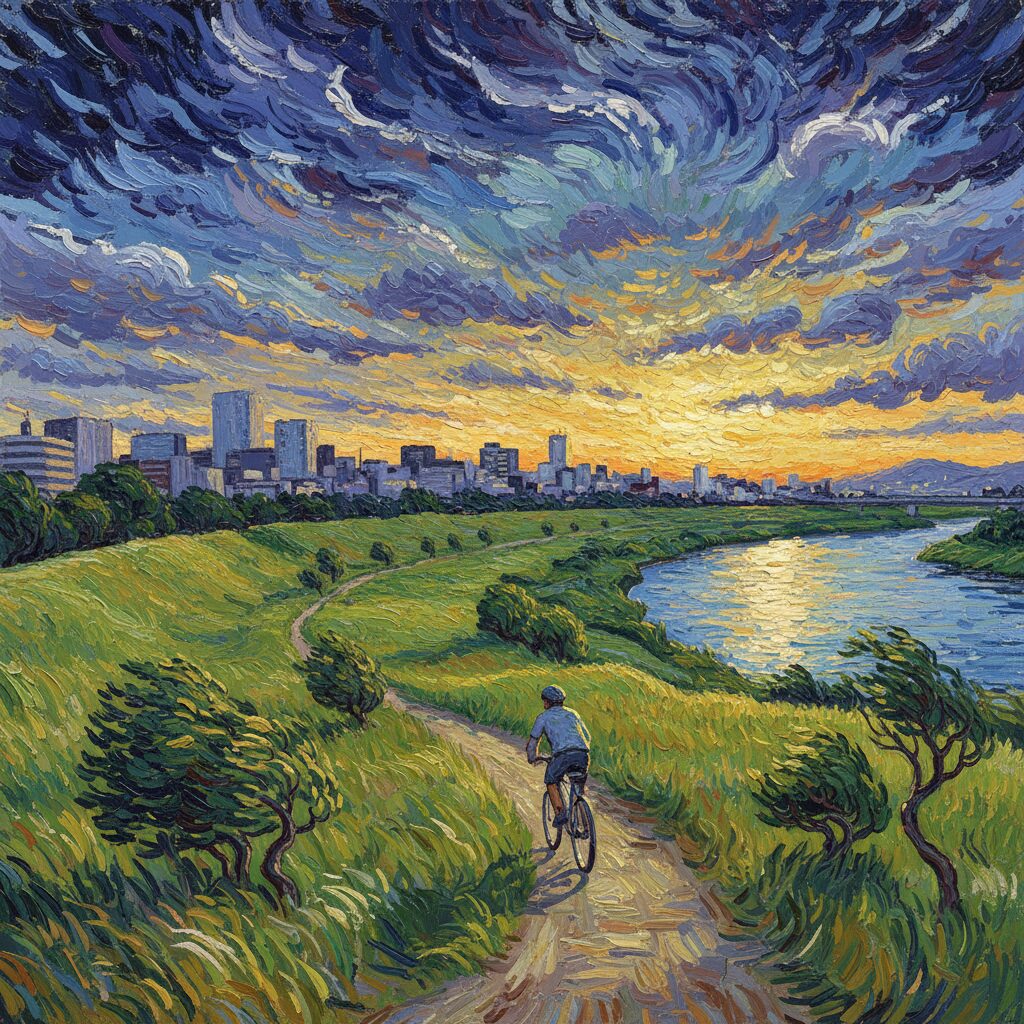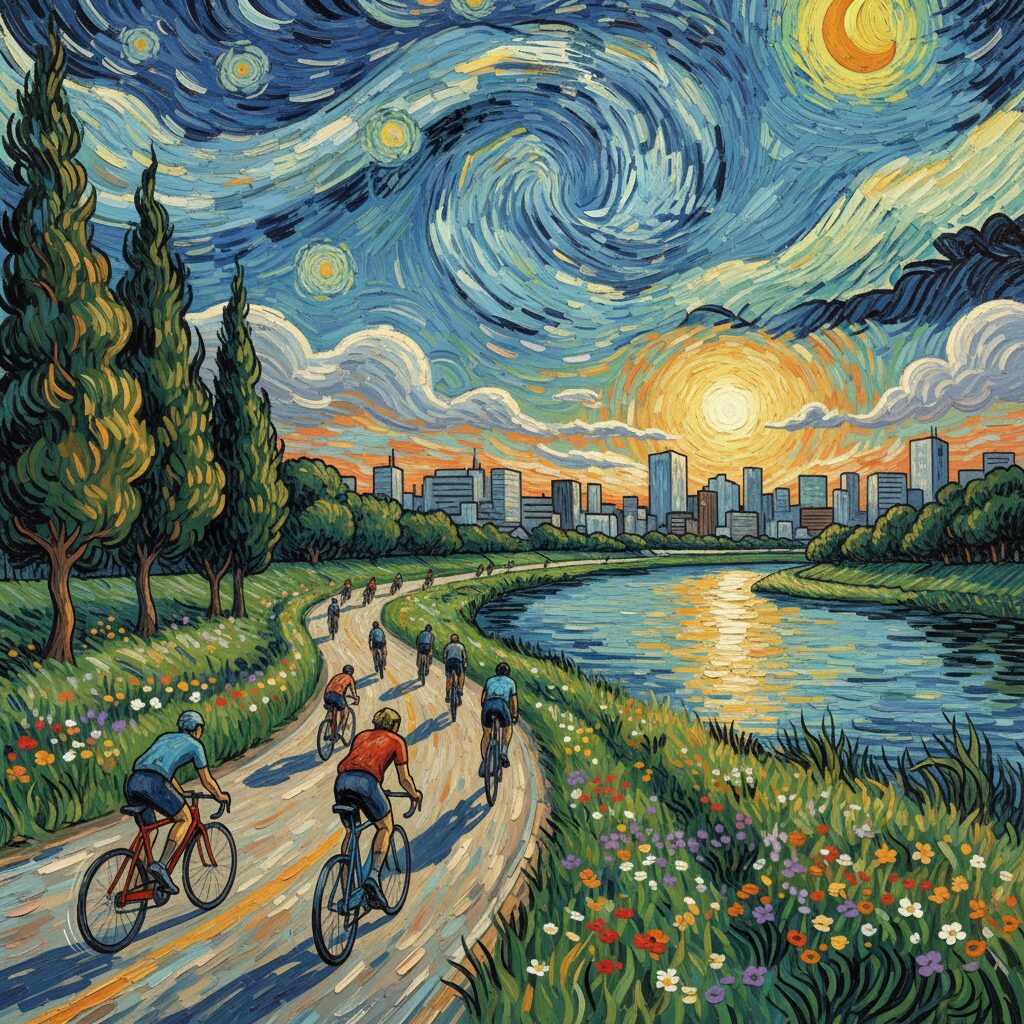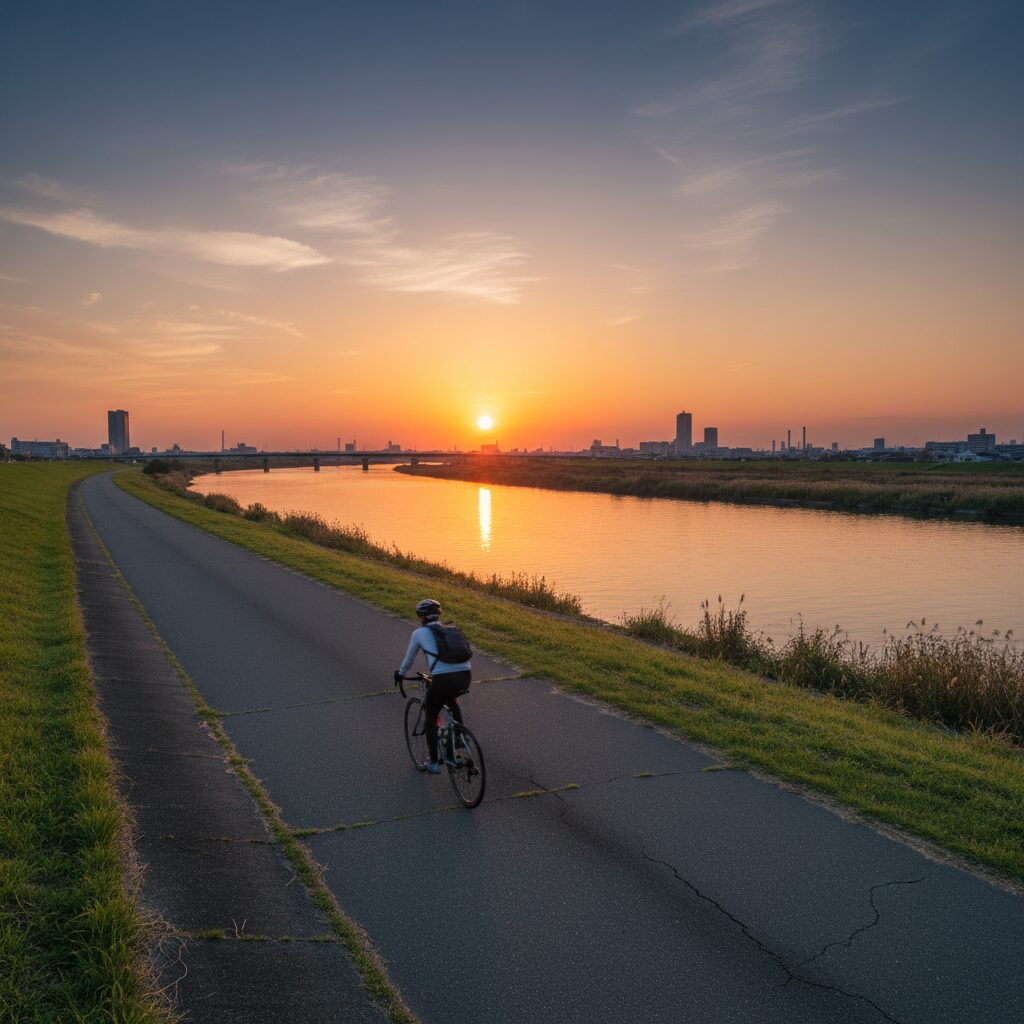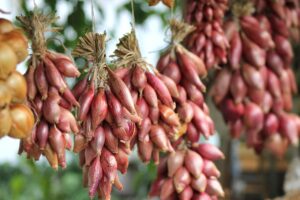In the heart of a metropolis that pulses with neon energy and hums with the constant motion of millions, there exists a place where the rhythm slows to the gentle, unhurried cadence of a flowing river. Osaka, a city celebrated for its electric nightlife, its delectable street food, and its wonderfully chaotic spirit, holds a secret sanctuary of wide-open space, a green and blue ribbon that offers a deep, calming breath to all who seek it. This is the Yodo River, and stretched along its generous banks is the Yodogawa Riverside Park, a sprawling network of greenery that serves as the city’s beloved backyard. To truly understand its scale, its soul, you must do more than simply stand on its edge. You must move with it. And there is no better way to sync your own rhythm with the river’s timeless flow than from the saddle of a bicycle, pedaling your way through a side of Osaka you never knew existed. Forget the crowded subways and the bustling shopping arcades for a day. Here, the only traffic is a gentle breeze, the only soundtrack is the chirping of birds and the distant laughter of families, and the only destination is a profound sense of peace. The journey along the Yodogawa is not about getting somewhere fast; it’s about rediscovering the simple joy of moving through a landscape that unfolds, kilometer by beautiful kilometer, at your own pace. It’s a ride into the heart of local life, a meditation in motion, and an escape that recharges the spirit right within the city’s limits.
The Journey Begins: A Breath of Open Air

The transition feels almost magical. One moment, you’re weaving through the familiar, narrow streets of a residential Osaka neighborhood, surrounded by tightly packed houses and a tangled network of power lines overhead. The next, you find yourself pushing your bicycle up a gentle grassy slope, and suddenly the world opens up. The sky, once just a narrow sliver between buildings, stretches out into an immense, uninterrupted canopy of blue. The air feels lighter and cleaner, carrying the subtle, earthy scent of river water and freshly cut grass. This is when you truly arrive at the Yodogawa Riverside Park. Finding the dedicated cycling path is easy; it’s a smooth, wide ribbon of asphalt that invites you onward, promising a ride free from cars and traffic lights. As your pedals begin to turn steadily, the city’s hum fades into a soft background murmur, replaced by a more natural soundtrack. You hear the whir of your tires on the pavement, the rustle of reeds along the riverbank, and the cheerful shouts of a baseball team practicing nearby. This isn’t a curated tourist spot; it’s a living, breathing part of the community. You cease to be a mere observer of Osaka life and start moving within it. Grandfathers teach their grandchildren to fly kites that soar and dip on the steady breeze. Couples stroll hand-in-hand, their conversations flowing with the rhythm of the river. Lone fishermen stand quietly in contemplation, their lines cast with hope. The vastness of the park system begins to unfold. It isn’t just one contained park, but a series of interconnected districts, or `chiku`, each with its own distinct character, stretching for dozens of kilometers from Osaka Bay all the way toward the ancient capital of Kyoto. The feeling is one of boundless freedom—a rare luxury in a country where space is often scarce. Here, you can ride for hours with the silver-blue stretch of the Yodogawa as your constant companion, the distant skyline of Umeda’s skyscrapers reminding you of the world you’ve momentarily left behind.
A River of History and Life
Cycling along the Yodo River means following a route deeply woven into the history of this region. This is more than just a river; it is the foundation upon which Osaka grew into a prominent merchant city. For centuries, the Yodogawa served as a crucial commercial artery linking the imperial court in Kyoto with Osaka’s bustling port and warehouses. As you pedal, you can almost picture the scene from centuries past: fleets of `jikkokubune` and `sanjikkokubune`, traditional shallow-draft boats, carrying rice, sake, textiles, and other valuable goods, poling and sailing along these same waters. Merchants and travelers moved between the two great cities, their journeys inspiring songs, stories, and a distinctive river culture. The bridges overhead, modern feats of steel and concrete, now stand where simple wooden crossings or ferry points once managed the flow of people and trade. The river brought Osaka its prosperity and earned it the nickname “the kitchen of the nation,” yet it was also a formidable force of nature. The broad, green floodplains you enjoy today are proof of Japan’s extraordinary engineering and its philosophy of harmonizing with, rather than opposing, nature. Historically, the Yodogawa suffered frequent and damaging floods, and the extensive system of high levees, overflow channels, and parklands is the result of more than a century of careful water management. This vast undertaking transformed a constant peril into a valuable public space, offering recreation, nature, and community cherished by Osaka’s residents. This historical backdrop adds depth to your ride—you’re not merely exercising but gliding through a living museum where the landscape tells the story of commerce, culture, and the enduring bond between a city and its river.
The Rhythm of the Ride: Exploring the Park Districts

The true joy of a Yodogawa cycling adventure comes from the subtle changes in scenery and atmosphere as you travel from one park district to the next. The path itself is a cyclist’s dream—meticulously maintained, well-marked, and delightfully flat for most of its stretch, making it accessible to riders of all ages and fitness levels. Beginning closer to the city center, perhaps near the Moriguchi or Owada districts, the park exudes a vibrant community spirit. The landscape here is sprinkled with beautifully tended sports fields. On any given weekend, the air is alive with the crack of baseball bats, the cheers from youth soccer matches, and the steady thump of tennis balls. It’s a wonderful place to experience the everyday pastimes of local Osakans, a vivid scene of uniformed teams and families enjoying their leisure. As you pedal further upstream toward Kyoto, the atmosphere shifts gradually to a more pastoral feel. The organized sports fields give way to wide, open meadows of grass. In the Hirakata district, you’ll find expansive lawns ideal for laying out a picnic blanket and watching the clouds drift by. This is where the pace truly eases. You’ll spot people practicing musical instruments, artists with easels capturing the sunlight on the water, and groups of friends simply lying in the sun, soaking in the calm. Continuing your journey, you might head to one of the river’s most famed locations: the Sewari-tei district. Situated where the Yodo River branches from the Katsura and Uji rivers, this place is legendary. In spring, it boasts a stunning 1.4-kilometer tunnel of cherry blossom trees. Riding beneath this canopy of pale pink petals is an experience of pure, unfiltered beauty, a moment that feels plucked from a dream. Even outside sakura season, the tree-lined path offers a lovely, shaded retreat—a peaceful green corridor that feels worlds away from the city. The journey isn’t just about the destination, but also the small discoveries along the way—a hidden bamboo grove, a quaint shrine tucked near the levee, or the sight of a majestic heron standing perfectly still in the shallows, waiting for its catch.
A Symphony of Seasons: When to Visit
Yodogawa Riverside Park is not just a seasonal destination; it evolves throughout the year, revealing a fresh and beautiful aspect each month. Your visit will be distinctly shaped by the season, with each period offering its own unique symphony of sights, sounds, and emotions. Spring stands out as the most dramatic and celebrated time. The burst of cherry blossoms, especially at the renowned Sewari-tei, attracts visitors from across the region. The soft pink and white blossoms contrast beautifully against the clear blue sky. Yet, the sakura are not the sole attraction. Expansive fields of vibrant yellow canola flowers, or `nanohana`, cover parts of the riverbank, creating a cheerful, painterly scene. The air feels fresh, filled with renewal and festivity. In summer, the park is draped in rich, vibrant green. The thick foliage provides welcome shade from the intense sun. Although afternoons may be hot and humid, mornings and evenings are delightful, with cool breezes drifting off the river offering natural relief. Summer also brings grand fireworks festivals, or `hanabi taikai`. Many communities along the Yodo River host spectacular shows, and finding a spot on the grassy banks to watch the sky light up is a quintessential Japanese summer experience. As summer’s heat fades, autumn arrives, bringing a gentle, wistful beauty. The air grows crisp and clear, ideal for long, pleasant bike rides. Cherry trees exchange their blossoms for fiery reds and oranges, while delicate cosmos flowers sway in the breeze, turning the meadows into a palette of pink, white, and magenta. Tall pampas grass, or `susuki`, lines the paths, glowing in the golden late afternoon light, creating a scene that feels poetic and serene. Winter presents a different, quieter charm. The crowds dwindle, and you might find yourself alone on long stretches of the path. Bare tree branches form intricate, skeletal patterns against the cold, clear sky. The air is so crisp that views of distant mountains and the city skyline appear sharper than ever. It is a season of peaceful solitude and an opportunity to appreciate the landscape’s raw structure. It’s also an excellent time for birdwatching, as migratory birds gather along the river, making it a haven for nature enthusiasts.
Practical Guide for Your Riverside Adventure

Setting off on a cycling trip along the Yodogawa is delightfully simple, yet a bit of preparation will enhance your experience. The park is extremely accessible, featuring numerous entry points along its entire stretch. One of the most convenient starting options is using the Keihan Main Line, which parallels the river for much of the distance between Osaka and Kyoto. Stations such as Moriguchishi, Owada, and Hirakata-kōen offer excellent access, each just a brief walk from the riverside paths. While bringing your own bicycle is possible, renting is generally the easiest option for most visitors. Local bike rental shops are often found near main train stations, though it’s wise to check availability online ahead of time since it can vary. Some larger park sections may also have rental facilities, especially during busy periods. When packing, keep it simple and practical. The Japanese sun can be intense even on cloudy days, making sunscreen and a hat essentials throughout the year. A refillable water bottle is necessary, as most main park areas have fountains for topping up. It’s also a good idea to bring some light snacks, although part of the fun is stopping at a convenience store, or konbini, near a station to pick up onigiri rice balls or a bento box for a picnic by the river. Don’t forget a small towel, or tenugui, which is wonderfully handy for wiping sweat or drying your hands. Navigating the park is straightforward. The primary cycling paths are clearly marked, and it’s hard to lose your way as long as you keep sight of the river. Restrooms are conveniently spaced every few kilometers within designated park zones, so you don’t need to worry about finding facilities. Lastly, a gentle reminder about local etiquette: in Japan, cyclists typically keep to the left side of the path. Since the route is shared with pedestrians, joggers, and families, always ride at a safe, controlled pace and be considerate of others. A friendly ring of your bell is the polite way to alert someone when passing from behind. By following these simple courtesies, you’ll comfortably blend in with the local flow of the park.
Beyond Cycling: Other Ways to Enjoy the Park
Although cycling is arguably the best way to cover the extensive areas of Yodogawa Riverside Park, it’s far from the only way to enjoy this fantastic space. The park is a versatile haven designed for all kinds of leisure and relaxation. Picnicking, for example, is a beloved national pastime in Japan with few better settings. The experience can be as simple or elaborate as you like. You might pick up a few items from a convenience store or indulge in the full depachika experience by visiting the basement food hall of a department store like Keihan in Moriguchi or Hirakata to assemble a gourmet bento box. Finding a quiet spot on a grassy bank, with the river’s gentle flow as your soundtrack, is a simple yet deeply satisfying pleasure. For those more active, the park offers an impressive range of facilities. Many districts include public barbecue areas where friends and families can grill together, though reservations are usually required. You’ll also find well-maintained baseball fields, soccer pitches, and tennis courts regularly used by local clubs and residents. Even as a spectator, it’s enjoyable to watch a game and soak up the community spirit. The park is also a paradise for photographers. The striking contrasts between the wide river, broad sky, modern bridges, and seasonal plants provide endless captivating subjects. Sunrise and sunset’s golden hours are especially magical, casting warm, soft light over the scenery and creating beautiful reflections on the water. Perhaps the most profound way to appreciate the park, however, is to embrace the art of doing nothing. In a culture that prizes efficiency and constant motion, Yodogawa offers a precious chance to simply be. Find a comfortable spot, lie back on the grass, read a book, listen to the breeze, or watch clouds drift overhead. This is the park’s greatest gift: a space to disconnect from the world’s demands and reconnect with nature’s calm, restorative rhythms.
The Soul of the River
As your day cycling along the Yodogawa comes to a close and you pedal back toward the urban landscape with tired legs and a full heart, you carry a fresh perspective on Osaka. You’ve discovered that just beyond the concrete and the crowds lies a place of profound tranquility and natural beauty. You’ve come to see the city not as a frantic machine, but as a community of people who cherish their green spaces, who gather by the river to play, reflect, and connect with one another. A journey through Yodogawa Riverside Park is more than a bike ride—it’s an immersion into the everyday life of the city, a glimpse into the history that shaped it, and a personal encounter with the changing seasons that define the Japanese aesthetic. It’s the feeling of the wind on your face, the view of a perfect sunset over the water, and the quiet satisfaction of having explored a landscape powered by your own effort. This is the other side of Osaka—calm, spacious, and deeply connected to nature. It’s an invitation to slow down, breathe deeply, and find your own peaceful rhythm in harmony with the timeless, steady flow of the great Yodo River. The next time you visit this vibrant city, listen for the quiet call of the river. It’s waiting to share its stories and serenity with you, one gentle pedal stroke at a time.


